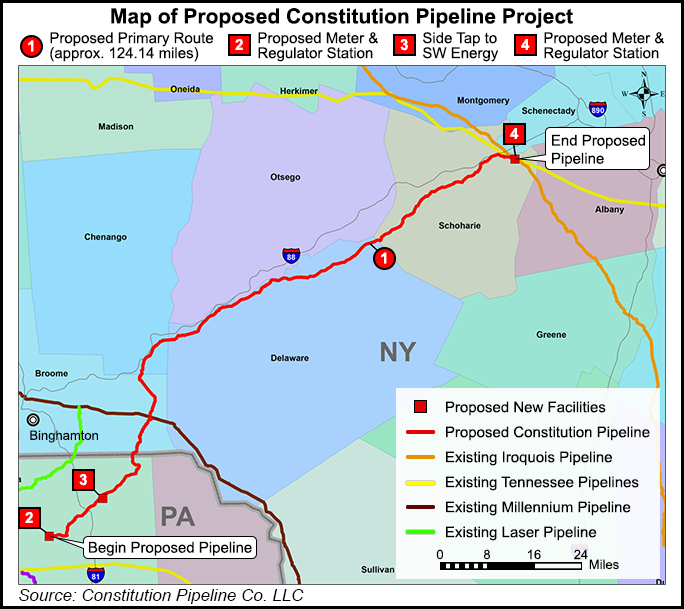Constitution Pipeline In-Service Date Pushed Back to 2H2017
With time running out to complete tree felling activities, Constitution Pipeline Co. LLC is pushing back the in-service date for its proposed Constitution natural gas pipeline from 4Q2016 to 2H2017, in order to comply with directives from FERC and the U.S. Fish and Wildlife Service (FWS) to protect wildlife along the pipeline’s route.

Constitution said Thursday the delay of its $683 million pipeline was necessary because of the “rapidly closing environmental window to complete tree felling activities prior to March 31.” The company said it has completed nearly all the necessary tree cutting in Pennsylvania.
On Jan. 29, the Federal Energy Regulatory Commission [CP13-499] gave Constitution permission to begin cutting trees in Pennsylvania, but not in neighboring New York State (see Shale Daily, Feb. 1). A federal district court judge ordered the work to resume after pipeline opponents briefly disrupted the tree-clearing activities in February (see Shale Daily, Feb. 24).
Constitution had hoped to finish the tree felling before March 31 to avoid affecting migratory birds and the northern long-eared bat, as ordered by FERC and the FWS. Under the revised timetable, the company said it hopes to begin limited mainline construction in the summer after it receives permission from the New York State Department of Environmental Conservation (DEC) and the U.S. Army Corps of Engineers (USACE).
Specifically, Constitution is waiting to receive Clean Water Act (CWA) Section 401 Water Quality Certification from the DEC. Once that certification is received, the USACE can proceed with issuing a CWA Section 404 permit for the project, followed by FERC issuing its notice to proceed.
Full mainline construction is now scheduled to resume after Oct. 1 to minimize and avoid impacts to migratory birds and the Northern long-eared bat.
Constitution spokesman Chris Stockton told NGI’s Shale Daily that the DEC has a statutory deadline of April 30 to process the water quality certification.
“We’ve been working with them for about three years now,” Stockton said Thursday. “When the DEC identified or raised concerns, we made modifications to our construction plan and methodologies in order to address them. We have a high degree of confidence that we are going to receive that permit. It’s really about the timing, and that’s something that right now is just not in our control.”
The saga over the Constitution Pipeline has lasted more than four years. The project had an original in-service date of March 2015. It was proposed in February 2012, and its backers began the pre-filing process with FERC two months later (see Shale Daily, April 27, 2012; Feb. 22, 2012). A formal application to FERC was filed in June 2013 and approved in December 2014 (see Shale Daily, Dec. 3, 2014;June 17, 2013).
“It has been a long process,” Stockton said.
In a note Thursday, analysts with Jefferies LLC said, “we think few investors still believed the pipeline would be online in 2016, as Constitution is still awaiting necessary approval from the DEC, but the push out to 2H2017 may be a longer delay than many expected.”
Constitution is owned by subsidiaries of Williams Partners LP, Cabot Oil & Gas Corp., Piedmont Natural Gas Co. Inc. and WGL Holdings Inc. The approximately 124-mile, 30-inch diameter pipeline will transport Marcellus gas produced in northeast Pennsylvania with existing transmission pipelines in Schoharie County, NY, where it would connect with two existing interstate pipelines: Iroquois Gas Transmission and Tennessee Gas Pipeline.
The pipeline would provide 650,000 Dth/d of takeaway capacity, with Cabot (500 MMcf/d) and Southwestern Energy Co. (150 MMcf/d) serving as shippers.
Constitution and Leatherstocking Gas Co. LLC have also announced plans to install four delivery taps along the proposed pipeline’s route (see Shale Daily, March 19, 2014).
The pipeline will originate in Susquehanna County before crossing into New York and traversing Broome, Chenango, Delaware and Schoharie counties.
New York State is no stranger to regulatory delays. The Millennium Pipeline, which traverses the state, went into service in December 2008 after a decade of planning (see Daily GPI, Dec. 23, 2008). Millennium Pipeline Co. LLC was given permission by FERC last month to use its pre-filing process to review the company’s proposal to upgrade and expand the eastern end of its system.
Last year, New York State officially banned high-volume hydraulic fracturing, in part after the DEC issued a blistering report — seven years in the making — on the practice (see Shale Daily, June 29, 2015).
© 2024 Natural Gas Intelligence. All rights reserved.
ISSN © 2577-9877 | ISSN © 2158-8023 |
